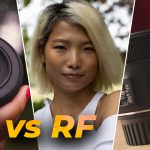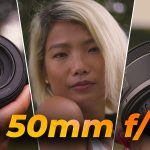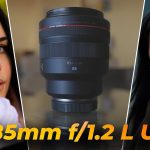Hey guys. In this article, we’re going to compare another two marvellous pieces of glass, the Canon RF 85mm f1.2 L USM, and the much more affordable Canon RF 50mm f1.8 STM.
In this review, we’re going to explore what these theoretically similar lenses can do, what their strengths and weaknesses are, and which one should you buy, if any.
Even though the RF 85mm lens is around fourteen times more expensive than the RF 50mm, I think comparing them might yield some interesting results. Is the RF 85mm lens really fourteen times better than the 50mm?
Let’s find out.

Aperture & Focal Length
First off, let’s start out with the aperture and focal length. As the name suggests, the RF 85mm f/1.2 L USM has a fixed focal length of 85mm, and the aperture opens as wide as f/1.2
The RF 50mm has a fixed focal length of 50mm, and the aperture dilates to a maximum of f/1.8. So, what does this all mean?
First off, both of these lenses have a fixed focal length, which generally means that they take sharper images, compared to lenses with a variable focal length.
An example of a lens with a variable focal length would be the Canon EF 75-300mm. I’ve actually reviewed this lens on my channel, links down below, or click the card in the top right corner if you’d like to watch that review as well.
In terms of aperture, the lower the number is, the more the lens opening can dilate, and thus more light is allowed to reach the sensor. The more light reaches it, the less severe your settings have to be, and thus you can avoid unwanted motion blur, or noisy shadows caused by low light.

85mm
Even though the 85mm and 50mm focal lengths have different uses, the 85mm is more favourable for portraits. This is because even though all lenses cause some sort of distortion to the image, the 85mm focal length is considered to be the most flattering for faces.
50mm is also great for portraits, but given that this lens is nicknamed the ‘nifty fifty’, you can safely assume that it’s more of a general purpose lens, which is good for all sorts of situations, including product photography, street photography, and more.
In fact, if doing street photography, I’d much rather use the 50mm lens, as opposed to the 85mm. Even though the 85mm would allow you to stand further from your subject, and thus make it far less likely that you’ll intimidate them, the 50mm is much smaller in size than the 85mm. We’ll get into the physical dimensions of this lenses in a bit.
When comparing the max apertures, f/1.2 is generally better, as it just means more light can come through, as opposed to the f/1.8. This means that you can shoot with less light, thus allowing you to extend your golden hour sessions even longer than expected.
Initially, I was ready to declare the RF 85mm lens the winner when it comes to focal length and aperture, but given the RF 50mm’s advantage in street photography, due to its size, I’m rather reluctant to call a winner in this category.
Next up, let’s have a look at the size and build of both of these optical marvels.

Size & Build
When it comes to build quality, the Canon RF 85mm f/1.2 actually wins hands down. Holding it in your hands is an absolute joy, the materials used make its exterior feel incredibly pro, and the overall construction has a satisfying weight to it.
In comparison, the RF 50mm isn’t quite as nicely built, and it’s rather lightweight and small, giving it an almost toy-like quality.
The RF 85mm lens weighs in at around 2.63lb, or just under 1.2kg. That’s quite hefty. In comparison to the RF 50mm’s 5.64 oz, or 160 grams, the 85mm feels like an absolute unit.
But the 85mm’s size advantage does not end here. When it comes to physical size, the 50mm is around 1.5″ inches in length, or close to 4cm, whilst the 85mm measures 4.62″, or nearly 12cm.
Once you add the included lens hood, things can get ridiculous, so if you’re going to carry this lens in your bag, make sure to invert the hood, so that you save up on some space.
Much like how the Canon RF 50mm f1.8 lens can be more inconspicuous in a street photography scenario, the RF 85mm’s prodigious girth can also be its downfall.
I’d be careful when walking around with it, as this lens absolutely screams Pro gear. Especially if you have it on an R5 camera body, you’ll want to be mindful of where you are, and pay extra attention if someone keeps glancing at your equipment.
Again, I’m reluctant to declare a winner in this category, as their sizes have different pros and cons. If we’re talking strictly build quality though, the crown naturally goes to he much more expensive RF 85mm lens.

Image Quality
Now that we’ve covered the physical properties of these two optical jewels, let’s delve into the abstract matter of deciding which ones takes better looking photos or videos.
First off, neither of these lenses have image stabilisation. But, if used on a camera body with in-body stabilisation, the RF mount allows communication between the lens and body, and thus you’ll actually get some stabilisation.
How much exactly depends on a myriad of factors, but in a minute I’ll show you some footage taken with both lenses, on a Canon R5 camera body, and you’ll be able to see for yourself.
Now, in terms of the images themselves, both lenses produce great photos. The fact that the RF 85mm can open up to f/1.2 does mean more Bokeh, so that’s important to bear in mind.
Honestly, we could sit here and talk all day, but I think it’s better that I just show you some examples of both photos and videos I’ve taken with both of these lenses.
We’ll start off with the RF 50mm lens first, and I’ll show you both videos, and then photos. Then, we’ll do the RF 85mm, starting with videos as well, and finishing with some photos.

Control
If you closely examine the surface of these two lenses, you’ll notice some similarities, but also some differences. For example, they both have AF/MF focus switches, and manual focus rings.
But, upon closer inspection, you’ll notice that the RF 85mm lens has an extra switch, as well as an extra ring. The extra switch allows you to restrict focus to either 1.5m, or infinity.
The extra ring is actually a control ring. If you go into the camera menu, you’ll be able to assign a function to this ring, like being able to adjust your shutter speed.
Even though this was a fantastic idea from Canon, as far as I know, most people who own this lens actually disable the feature. The reason is because it is far too easy to accidentally hit it during a shoot, and change your settings without realising it.
Longevity
When it comes to durability, these lenses exist at opposite sides of the spectrum. Whilst the Canon RF 85mm f/1.2 L USM has weather-sealing, the RF 50mm f/1.8 does not.
I always recommend you get a filter for your lenses, and I personally use Sigma ceramic filters. Even though they’re relatively pricey, they’re really good quality, and I’d rather smash up a filter which costs a fraction of the price of the RF 85mm f/1.2, rather than damage the lens element itself.

Conclusion
In conclusion, which one should you buy? The more affordable RF 50mm f/1.8 lens, or the eye-wateringly expensive Canon RF 85mm f/1.2 L USM?
As you might have gathered from this review so far, both of these lenses have pros and cons, and they’re both good at different things.
For example, even though they’re both fantastic when taking photos, because of the RF mount, and the Canon R5’s built-in image stabilisation, both of these lenses can produce decent handheld video, especially if it’s in slow motion.
When it comes to build quality and durability, the RF 85mm is the winner, as it is a much nicer lens to hold, and because it has weather-sealing.
Street Photography
However, when you have a need to be inconspicuous though, like when doing street photography, the much smaller and definitely cheaper looking RF 50mm lens is your friend.
When looking at the video and photo examples I’ve provided with you earlier, did you notice some differences? Perhaps. The RF 85mm can take cleaner photos in lower light, and it has nicer, richer Bokeh.
But with that in mind, does the fact that the 85mm lens is fourteen times more expensive make it fourteen times better? I’d argue that it doesn’t.
If you’re a beginner, intermediate photographer, or a hobbyist, I’d recommend just getting the RF 50mm f/1.8 lens, and really learning what it can do.
If, on the other hand, you are a professional, or you would like to graduate to that level, the Canon RF 85mm f/1.2 L USM is definitely one of the lenses that you need to have in your bag.
By the way, I’ve actually reviewed both of these lenses separately on my YouTube channel. If you’d like to delve deeper into what each of them can do, you can learn more there.
If you’d like to purchase any of the items I’ve mentioned in this article, or see how much they cost in your country, I have a link down below where you can view them.
Thank you for reading my comparison review between the Canon RF 85mm f1.2 vs Canon RF 50mm f1.8 STM. I invite you to have a look at some of my other articles. We have something for everyone, whether you’re interested in audio, or cameras and lenses. Alternatively, if you prefer video reviews, feel free to have a look at my YouTube channel.

Product Links
Down below you will find all of the items I talked about in this article.



